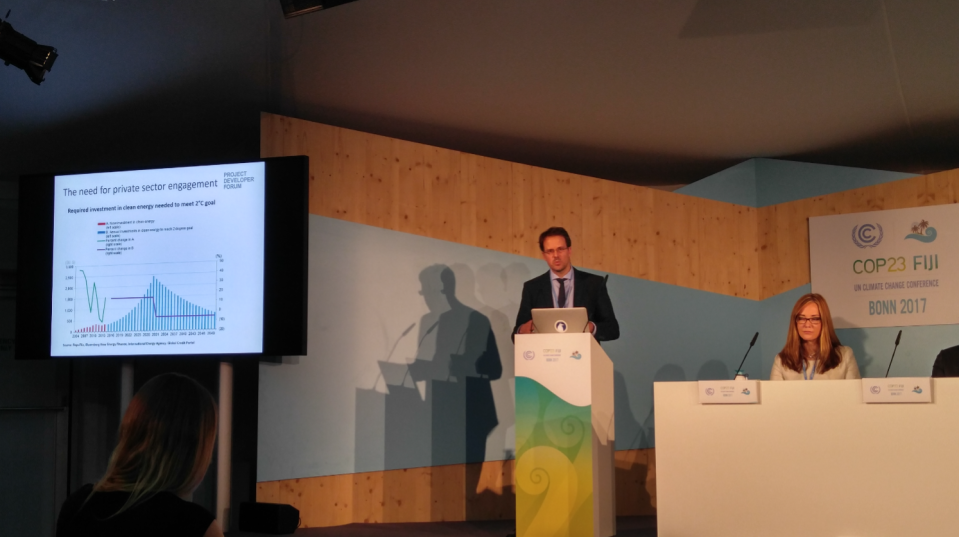Over the past couple of days I’ve identified two very different perspectives on the climate change negotiations being described in side events and panels.
The first is a predominantly markets-based perspective that sees carbon markets and private finance as the key to achieve global emissions reductions. The other is a social-movements-based approach that sees the forced phase-out of fossil-fuels coupled with public funding for renewables as the key strategies for curbing climate change. In this blog post, I want to look a big more closely at each of these perspectives and who supports them.
Let’s start by looking at the markets-based perspective. The markets-based climate action narrative is a pragmatic one. It is embraced by most governments here at the negotitions, and it builds on the legacy of the market-based “clean development mechanisms” that emerged from the Kyoto Protocol. To put it simply, the idea underpinning the markets-based perspective is that emissions reductions anywhere in the world are equivalent. It doesn’t matter if a ton of CO2 is prevented from entering the atmosphere in Brazil, or China, or Australia, since it all collects in the same atmosphere. At the end of the day, a ton is a ton. And therefore under the Paris Agreement, if a country is having a difficult time reducing it’s emissions to the level it has pledged, it will be allowed to pay for emissions reduction “credits” generated via privately financed projects around the world. These credits are created when projects prevent CO2 from entering the atmosphere in one way or another, whether through improved forest management to sequester carbon, destruction of refrigerant gasses with high greenhouse gas potentials, or the installation of biogas and renewable energy in areas where the financing would otherwise have been unavailable. Each ton of CO2 prevented from entering the atmosphere is awarded a credit, and after independent verification, can be bought and sold through exchanges by countries where it would then count towards their own emissions reduction targets.
The benefit of this approach is the improved flexibility it gives to governments for achieving their emissions reduction targets. The shortcomings, however, are numerous. First there is the problem of proving that the emissions reductions projects receiving credits would not have been pursued otherwise. This is known as the “additionality” problem, and it is impossible to prove definitively. Second, by allowing carbon credits generated abroad to be counted towards domestic emissions reduction targets, domestic communities which experience industrial CO2 emissions don’t enjoy the co-benefits of reducing emissions locally, which can include reduced asthma incidences and improved air quality. Thirdly, by allowing carbon credits to be purchased and used by governments towards their emissions reduction goals, this system can delay systemic transformations such as eliminating coal and oil electricity generation by providing a more politically-feasible, if not entirely scientifically valid, alternative.
Multiple events I’ve attended in the past couple days have focused on developing these market-based emissions reduction schemes. These tend to be dominated by business alliances (e.g. the World Business Council on Sustainable Development, Sustainable Cement Initiative), industry trade groups (e.g. the Climate Markets and Investment Association, the Project Developer Forum), and financial institutions (e.g. the Asian Development Bank). They also include high-level government officials . For instance, the Government of Morocco sent one of it’s Directors in the Ministry of the Environment to a panel I attended to present on “The Role of Market Mechanisms in Morocco’s [Nationally Determined Contribution] NDC Implementation Strategy” (pictured below).
Markets-minded conference attendees are paying particular attention to the negotiations happening on Article 6 of the Paris Agreement, which describes these market-based approaches to fulfilling NDC pledges, and how the Parties will define the rules around additionality, oversight, and projects/sectors eligible for carbon trading.

Muhammed Nbou, Director in the Moroccan Ministry of the Environment, presenting at a side event titled “Market Mechanisms 2.0: Moving from the Kyoto Regime to the Paris Scheme”

Patrick Burgi from the South Pole Group (representing the carbon market Project Developer’s Forum) presenting on “Operationalization of Articles 6.2 and 6.4” in the Paris Agreement related to market mechanisms.
In contrast, the other approach to climate change policy I’ve encountered here favors a social-movement-based phase out of fossil fuels and large-scale public sector financing of renewable energy projects. This approach has largely developed in response to the expansion in fossil fuel exploration and consumption around the world, particularly as frontline and indigenous communities experiencing the harms of fossil fuel extraction and energy-production first-hand organize themselves through the international climate justice movement. Their approach follow this logical framework:
- “At present, fossil fuel operations, be they coal mines or oil wells, fracking rigs or oil pipelines, coal-fired power plants or oil refineries, are harming our communities.”
- “At the same time scientists are saying we need to keep large amounts of remaining fossil fuels in the ground to meet the Paris Agreement temperature targets.”
- “Therefore, in order to prevent future harm to ourselves, future generations, and the planet, we must push the government to stop building new fossil fuel infrastructure, close existing infrastructure, and invest in renewable energy alternatives that place the wellbeing of us, the people, ahead of businesses and profits.”
- “In addition, we must seek to place pressure on banks and investment funds to divest themselves from the fossil fuel companies exploring for, extracting, and burning fossil fuels in our communities.”
The benefit of this approach is that it is relatively straightforward to organize communities in opposition to specific fossil fuel projects and to receive media attention. A con to this approach is that oftentimes governments are eager to please the fossil fuel companies behind these activities, whether for tax reasons, the economic benefits they provide, or simply corruption payments. This can lead to brutal crackdowns on protesters by private or national security forces. Another con is that it can be difficult to translate victories over fossil fuel interests in specific areas into national policies opposing fossil fuels and favoring renewables.
This social-movements-based approach is followed mostly by environmental groups (e.g. Friends of the Earth, 350.org, Rainforest Action Network), grassroots organizations in frontline and indigenous communities (e.g. International Coal Network in the Philippines, Health of Mother Earth Foundation in Nigeria), anti-corporate think-tanks (e.g. Corporate Europe Observatory, Oil Change International), and scientific activist organizations (e.g. Food and Water Watch, Center for Biological Diversity).
These social-movement-based groups are paying close attention to the negotiations happening on Article 9 of the Paris Agreement on climate finance for adaptation and mitigation from developed countries. There is also strong interest in Article 8 which focuses on loss and damage compensation for those affected by climate change.

Representatives from Nigerian, American, Filipino, Indonesian, Scottish, Belgian, and Indian social-movement-based organizations at a panel titled “Reclaiming Power: People vs Polluters in the Energy Transformation”

Pascoe Sabido of the social-movements-based Corporate Europe Observatory presenting on the influence of natural gas industry lobbying in the EU Parliament at a side event titled “Fossil Gas: Pathway to a Clean Energy Future or a Route to Dangerous Climate Change?”
Some may ask why I’m framing these approaches as if they oppose one another. Surely they can work together towards the common goal of saving the climate? To these people I would answer by painting an image: These two ideological camps are playing tug of war, pulling on a rope representing the global discussion on climate change action. Governments, businesses, banks, and big green organizations like the Environmental Defense Fund and the Nature Conservancy are on one side (i.e. the neoliberals and the capitalists), while civil society, environmental scientists, and frontline and indigenous communities are on the other (i.e. the systems-changers). Whichever side pulls the hardest on the rope wins. The markets-based side pulls using money and lobbying, while the social-movements-based side pulls using people power and community organizing.
Who will ultimately win is still up in the air, but one thing is clear: the markets-based neoliberals and capitalists are currently winning. People must respond by mobilizing to call for an end to fossil fuel use and a just transition to a sustainable society. It’s time to remind our countries and our politicians who they’re negotiating for… and what we have at stake.

– – – – –
Thanks for visiting aarondanowski.com! Leave you comments below, and be sure to stay up to date on my travels by clicking on the “Following” button on the right hand side of your page.
